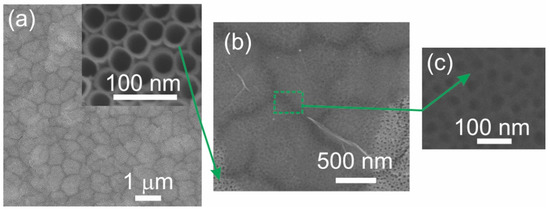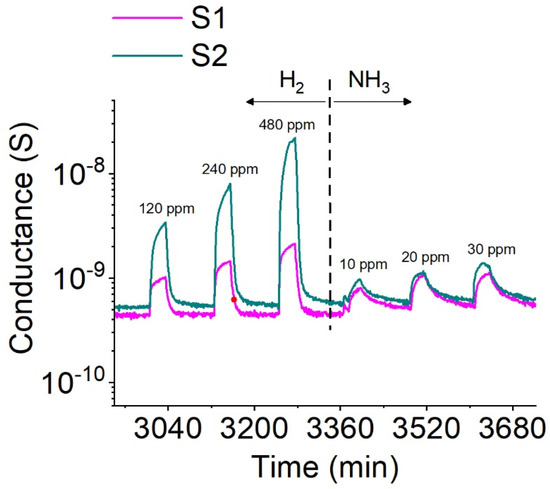Abstract
We studied the preparation and gas-sensing performance of a hybrid nanomaterial based on titania nanotubes and graphene derivatives. We fabricated the hybrid structure with tunable chemical-sensing properties, achieved by tailoring the structure and composition of graphene oxide and coupling it with titania nanotubes. The parameters of manufactured sensing structures were investigated for hydrogen and ammonia. Our experimental findings indicate that this research may demonstrate an efficient way to enhance the gas-sensing properties of metal oxide nanomaterials for health and safety applications.
1. Introduction
Modern gas-sensing systems based on nanotechnology may enable reliable and continuous detection of different gaseous compounds to control atmospheric pollutants and protect human health [1,2,3,4,5]. With their quantum-mechanical properties, wide-bandgap semiconductor nanostructures can affect the characteristics of functional devices [6,7,8]. Therefore, the application of semiconductor nanomaterials in the development of chemical gas sensors is of great interest [9,10,11]. Highly ordered transition metal oxide nanostructures have been considered as promising materials for applications in chemical gas sensors due to their good chemical stability and functional properties [12]. In this regard, well-ordered and highly aligned titania nanotubes, with their superior electron transport properties and large surface area, are very attractive structures for the fabrication of gas-sensing systems [13,14,15,16,17]. Herein, we report the preparation and investigation of sensing properties of titania-based nanotubular structures for their application in gas-detection devices. We studied the effect of the additive material on the functionalities of nanotubes to optimize their sensing performance. The morphology, structure, and composition of prepared materials were examined. The sensing properties of materials were studied for hydrogen (H2) and ammonia (NH3). We have analyzed the interaction mechanism between the prepared nanotubes and gaseous compounds, considering their structural and compositional modifications. The obtained results demonstrate that the fabricated sensing materials have potential for application in detection systems [17].
2. Materials and Methods
Titania nanotubes were prepared as follows: The metallic titanium films were deposited on alumina substrates by radio frequency magnetron sputtering. Then, metallic films were anodized in a two-electrode system Teflon cell at room temperature. We reported the detailed information on anodization procedure in our previous reports [16,18]. The prepared materials were crystallized via thermal treatment in a tubular furnace at 400 °C for 6 h. We reported the crystallization regimes and analysis of the samples in [19]. The morphological analysis of samples (Figure 1) was performed by means of a LEO 1525 scanning electron microscope (SEM) equipped with a field emission gun. In order to fabricate the hybrid material, we prepared an aqueous dispersion of graphene oxide. Then, we drop-casted the prepared dispersion on the surface of titania nanotubes. To carry out gas-sensing measurements, platinum electrodes and a heater were deposited on the surface of the sensing structures and on the backside of substrates by DC magnetron sputtering. The gas-sensing tests were performed in a test chamber and the measurements were controlled by a computer-controlled gas flow system. The sensor based on pure titania is denoted as S1 and the sensor based on the composite material is denoted as S2 (Figure 2).

Figure 1.
SEM images of the obtained samples. (a) The surface morphology of pristine titania nanotubes with different resolutions; (b,c) the morphologies of the fabricated composite material with different resolutions.

Figure 2.
The dynamic response of obtained S1 and S2 sensors for different concentrations of H2 and NH3 at 200 °C.
3. Results and Discussion
The results of the morphological analysis of samples are shown in Figure 1. The SEM observations confirmed that highly ordered titania nanotubes were successfully prepared. The tube diameter was 30 nm (Figure 1a). Figure 1b,c shows the surface morphology of the composite structure. As can be seen, the surface of the titania nanotubes was covered by graphene oxide sheets. Figure 2 presents the dynamic response of the fabricated S1 and S2 sensors for concentrations of 120, 240, and 480 ppm of H2 and 10, 20, and 30 ppm of NH3. The sensing measurements were carried out at 200 °C. The graphene oxide significantly increased the response of the titania nanotubes towards H2. Meanwhile, very small differences were observed between the sensing behavior of the S1 and S2 structures towards NH3. The drastic enhancement in the response of the S2 sensor compared to S1 can be attributed to the depletion layer formed between the titania nanotubes and graphene oxide. In this case, the presence of more active centers improved the adsorption of H2 on the surface of the hybrid material, which is important for its sensitivity.
4. Conclusions
We fabricated a hybrid structure based on titania nanotubes and graphene oxide. Then, we investigated its gas-sensing performance for H2 and NH3. Our experimental findings show that the depletion layer formed between two materials plays a crucial role in tuning the sensing response of the hybrid structure. The hybrid material exhibited a better sensing response towards H2 compared to pristine titania nanotubes, indicating that this this is an efficient and promising way to enhance the sensing parameters of metal oxide gas sensors. Moreover, a noticeable difference between the responses of the composite structure and pristine nanotubes towards NH3 was not observed, which indicates an enhancement in the selectivity of the composite.
Funding
This work was partially funded by the NATO Science for Peace and Security Programme under grant No. G5634 “Advanced Electro-Optical Chemical Sensors”; by the “Multi-Messenger and Machine Learning Monitoring of SARS-CoV-2 for occupational health & safety” (4M SARS-CoV-2) project under the Special Integrative Fund for Research (FISR), Ministry of University and Research (MUR), Italy; and by the MIUR “Smart Cities and Communities and social innovation”, for the project titled “SWaRM Net/Smart Water Resource Management—Networks”.
Institutional Review Board Statement
Not applicable.
Data Availability Statement
The data that support the findings of this study are available from the corresponding author (V.G.), upon reasonable request.
Conflicts of Interest
The authors declare no conflict of interest.
References
- Ahoulou, S.; Perret, E.; Nedelec, J.-M. Functionalization and characterization of silicon nanowires for sensing applications: A review. Nanomaterials 2021, 11, 999. [Google Scholar] [CrossRef] [PubMed]
- Fioravanti, A.; Marani, P.; Morandi, S.; Lettieri, S.; Mazzocchi, M.; Sacerdoti, M.; Carotta, M.C. Growth mechanisms of ZnO micro-nanomorphologies and their role in enhancing gas sensing properties. Sensors 2021, 21, 1331. [Google Scholar] [CrossRef] [PubMed]
- Cai, Z.; Park, S. Effect of nanoparticle-embedded 1 dimensional-nanostructures to fabricate highly sensitive and selective hydrogen gas sensors. J. Alloys Compd. 2021, 865, 158929. [Google Scholar] [CrossRef]
- Galstyan, V.; Kaur, N.; Zappa, D.; Núñez-Carmona, E.; Sberveglieri, V.; Comini, E. Chemical gas sensors studied at sensor lab, brescia (italy): From conventional to energy-efficient and biocompatible composite structures. Sensors 2020, 20, 579. [Google Scholar] [CrossRef] [PubMed] [Green Version]
- Zhang, G.; Hosomi, T.; Mizukami, W.; Liu, J.; Nagashima, K.; Takahashi, T.; Kanai, M.; Sugiyama, T.; Yasui, T.; Aoki, Y.; et al. A thermally robust and strongly oxidizing surface of WO3 hydrate nanowires for electrical aldehyde sensing with long-term stability. J. Mater. Chem. A 2021, 9, 5815–5824. [Google Scholar] [CrossRef]
- Lu, Y.; Purwidyantri, A.; Liu, H.; Wang, L.; Shih, C.; Pijanowska, D.G.; Yang, C. Photoelectrochemical detection of β-amyloid peptides by a TiO2 nanobrush biosensor. IEEE Sens. J. 2020, 20, 6248–6255. [Google Scholar] [CrossRef]
- Agrawal, M.; Prathyusha, E.; Ahmed, H.; Dubey, S.K.; Kesharwani, P.; Singhvi, G.; Naidu, V.G.M.; Alexander, A. Biomaterials in treatment of alzheimer’s disease. Neurochem. Int. 2021, 145, 105008. [Google Scholar] [CrossRef] [PubMed]
- Galstyan, V. “Quantum dots: Perspectives in next-generation chemical gas sensors”—A review. Anal. Chim. Acta 2021, 238192. [Google Scholar] [CrossRef] [PubMed]
- Milovanov, Y.S.; Skryshevsky, V.A.; Gavrilchenko, I.V.; Kostiukevych, O.M.; Gryn, S.V.; Alekseev, S.A. Ethanol gas sensing performance of electrochemically anodized freestanding porous sic. Diam. Relat. Mater. 2019, 91, 84–89. [Google Scholar] [CrossRef]
- Fioravanti, A.; Carotta, M.C. Year 2020: A snapshot of the last progress in flexible printed gas sensors. Appl. Sci. 2020, 10, 1741. [Google Scholar] [CrossRef] [Green Version]
- Nikolic, M.V.; Milovanovic, V.; Vasiljevic, Z.Z.; Stamenkovic, Z. Semiconductor gas sensors: Materials, technology, design, and application. Sensors 2020, 20, 6694. [Google Scholar] [CrossRef] [PubMed]
- Galstyan, V. Porous TiO2-based gas sensors for cyber chemical systems to provide security and medical diagnosis. Sensors 2017, 17, 2947. [Google Scholar] [CrossRef] [PubMed] [Green Version]
- Chang, Y.H.; Liu, C.M.; Chen, C.; Cheng, H.E. The heterojunction effects of TiO2 nanotubes fabricated by atomic layer deposition on photocarrier transportation direction. Nanoscale Res. Lett. 2012, 7, 231. [Google Scholar] [CrossRef] [PubMed] [Green Version]
- Haryński, Ł.; Grochowska, K.; Kupracz, P.; Karczewski, J.; Coy, E.; Siuzdak, K. The in-depth studies of pulsed UV laser-modified TiO2 nanotubes: The influence of geometry, crystallinity, and processing parameters. Nanomaterials 2020, 10, 430. [Google Scholar] [CrossRef] [PubMed] [Green Version]
- Yadav, S.; Nair, A.; Urs Mb, K.; Kamble, V.B. Protonic titanate nanotube–reduced graphene oxide composites for hydrogen sensing. ACS Appl. Nano Mater. 2020, 3, 10082–10093. [Google Scholar] [CrossRef]
- Galstyan, V.; Comini, E.; Baratto, C.; Ponzoni, A.; Ferroni, M.; Poli, N.; Bontempi, E.; Brisotto, M.; Faglia, G.; Sberveglieri, G. Large surface area biphase titania for chemical sensing. Sens. Actuators B-Chem. 2015, 209, 1091–1096. [Google Scholar] [CrossRef] [Green Version]
- Tian, X.; Cui, X.; Lai, T.; Ren, J.; Yang, Z.; Xiao, M.; Wang, B.; Xiao, X.; Wang, Y. Gas sensors based on TiO2 nanostructured materials for the detection of hazardous gases: A review. Nano Mater. Sci. 2021, in press. [Google Scholar] [CrossRef]
- Galstyan, V.; Vomiero, A.; Comini, E.; Faglia, G.; Sberveglieri, G. TiO2 nanotubular and nanoporous arrays by electrochemical anodization on different substrates. RSC Adv. 2011, 1, 1038–1044. [Google Scholar] [CrossRef]
- Galstyan, V.; Ponzoni, A.; Kholmanov, I.; Natile, M.M.; Comini, E.; Sberveglieri, G. Highly sensitive and selective detection of dimethylamine through Nb-doping of TiO2 nanotubes for potential use in seafood quality control. Sens. Actuators B Chem. 2020, 303, 127217. [Google Scholar] [CrossRef]
Publisher’s Note: MDPI stays neutral with regard to jurisdictional claims in published maps and institutional affiliations. |
© 2021 by the authors. Licensee MDPI, Basel, Switzerland. This article is an open access article distributed under the terms and conditions of the Creative Commons Attribution (CC BY) license (https://creativecommons.org/licenses/by/4.0/).